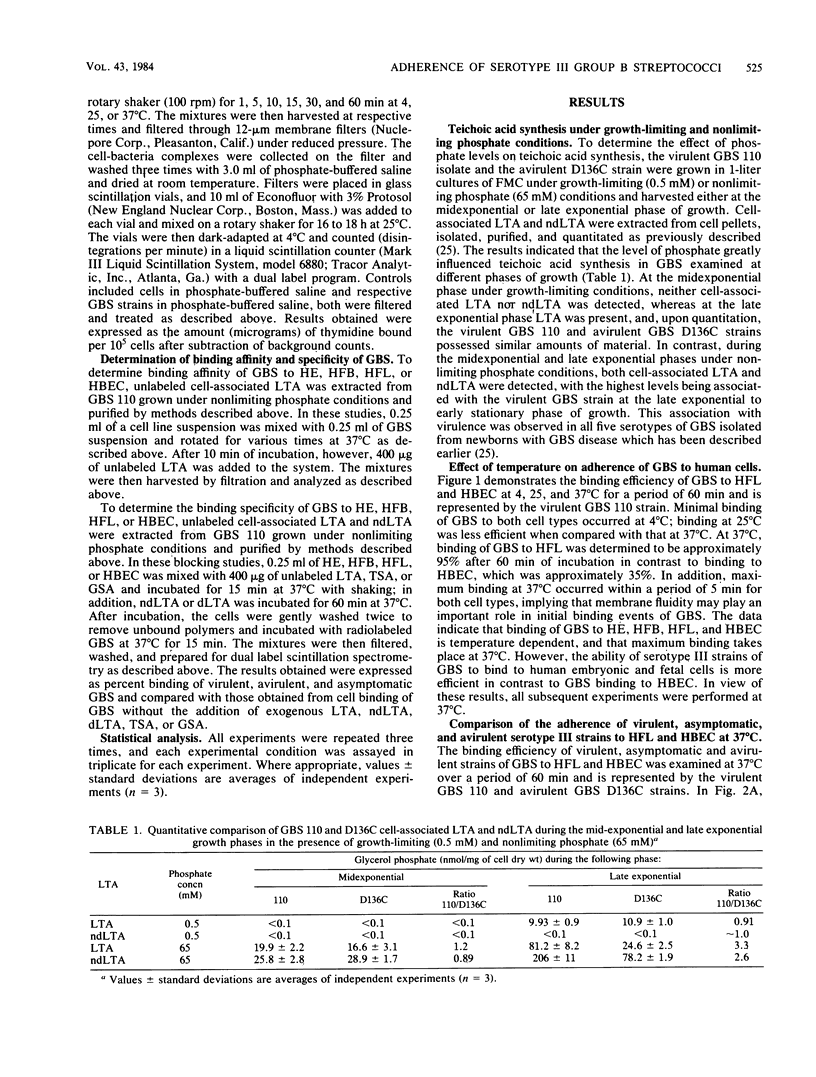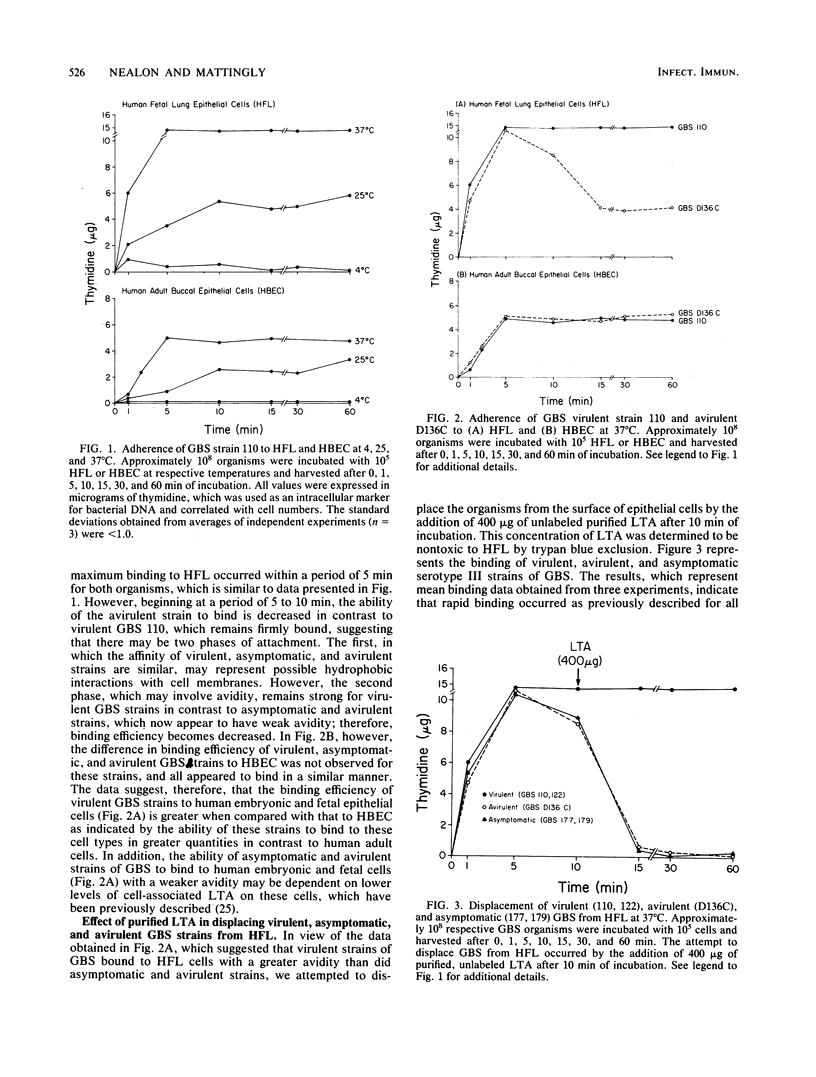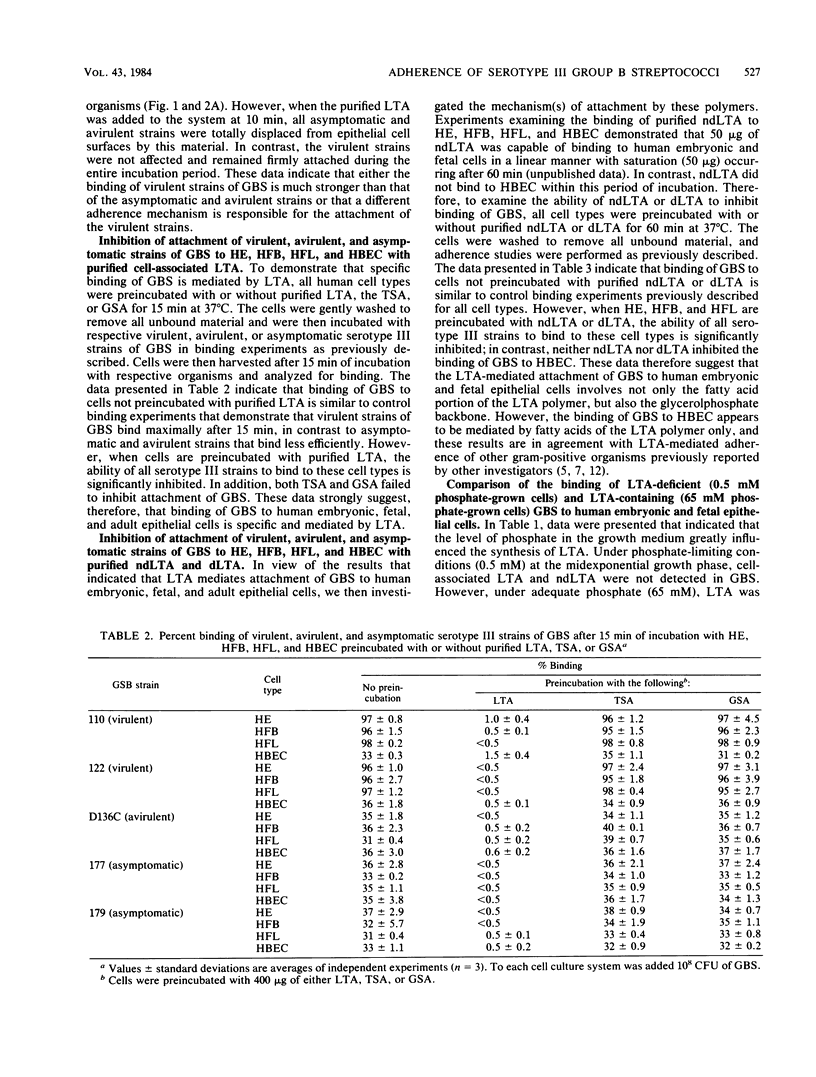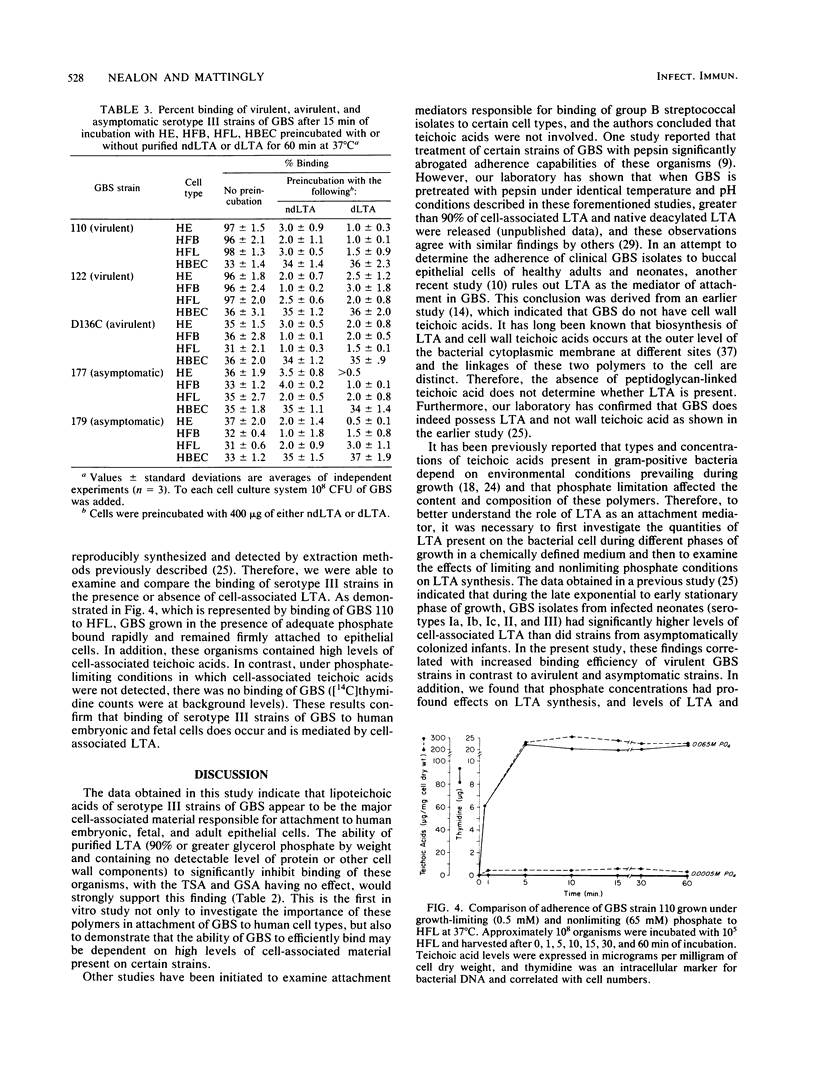Abstract
Lipoteichoic acids (LTA) of serotype III strains of group B streptococci (GBS) were shown to mediate adherence of these organisms to human embryonic (HEC), fetal (HFC), and adult buccal (HBEC) epithelial cells. The binding of GBS was temperature dependent, and maximum attachment occurred at 37 degrees C. HEC, HFC, and HBEC preincubated with purified LTA significantly inhibited attachment of GBS, whereas the group B and type III antigens had no effect. Under phosphate-limiting conditions in which cell-associated LTA could not be detected in these organisms, bacterial adherence did not take place. GBS (virulent) that were isolated from infected infants and previously shown to have significantly higher quantities of cell-associated LTA in comparison to GBS strains from asymptomatically colonized infants adhered with greater binding avidity to HEC and HFC and in greater numbers than to HBEC. It was determined that the mechanism of LTA-mediated adherence of GBS to HBEC differed from adherence to embryonic and fetal cells for both virulent and asymptomatic GBS strains bound to HBEC in a similar manner, enhanced by the lipid portion of the LTA. In contrast, the binding of GBS to HEC and HFC was mediated by hydrophobic as well as specific interactions due to the glycerolphosphate polymer of LTA. These results indicate that possible receptor sites for LTA present on cells in prenatal stages of development may differ from those of adult cells, which may result in increased susceptibility of newborn infants to group B streptococcal disease. The implications of LTA-mediated adherence of GBS and their possible role as virulence factors are discussed.
Full text
PDF







Selected References
These references are in PubMed. This may not be the complete list of references from this article.
- Anthony B. F., Okada D. M. The emergence of group B streptococci in infections of the newborn infant. Annu Rev Med. 1977;28:355–369. doi: 10.1146/annurev.me.28.020177.002035. [DOI] [PubMed] [Google Scholar]
- Baker C. J., Barrett F. F., Gordon R. C., Yow M. D. Suppurative meningitis due to streptococci of Lancefield group B: a study of 33 infants. J Pediatr. 1973 Apr;82(4):724–729. doi: 10.1016/s0022-3476(73)80606-7. [DOI] [PubMed] [Google Scholar]
- Baker C. J., Barrett F. F. Group B streptococcal infections in infants. The importance of the various serotypes. JAMA. 1974 Nov 25;230(8):1158–1160. [PubMed] [Google Scholar]
- Baker C. J., Barrett F. F. Transmission of group B streptococci among parturient women and their neonates. J Pediatr. 1973 Dec;83(6):919–925. doi: 10.1016/s0022-3476(73)80524-4. [DOI] [PubMed] [Google Scholar]
- Beachey E. H. Binding of group A streptococci to human oral mucosal cells by lipoteichoic acid. Trans Assoc Am Physicians. 1975;88:285–292. [PubMed] [Google Scholar]
- Beachey E. H., Dale J. B., Simpson W. A., Evans J. D., Knox K. W., Ofek I., Wicken A. J. Erythrocyte binding properties of streptococcal lipoteichoic acids. Infect Immun. 1979 Mar;23(3):618–625. doi: 10.1128/iai.23.3.618-625.1979. [DOI] [PMC free article] [PubMed] [Google Scholar]
- Beachey E. H., Ofek I. Epithelial cell binding of group A streptococci by lipoteichoic acid on fimbriae denuded of M protein. J Exp Med. 1976 Apr 1;143(4):759–771. doi: 10.1084/jem.143.4.759. [DOI] [PMC free article] [PubMed] [Google Scholar]
- Botta G. A. Hormonal and type-dependent adhesion of group B streptococci to human vaginal cells. Infect Immun. 1979 Sep;25(3):1084–1086. doi: 10.1128/iai.25.3.1084-1086.1979. [DOI] [PMC free article] [PubMed] [Google Scholar]
- Bramley A. J., Hogben E. M. The adhesion of human and bovine isolates of Streptococcus agalactiae (group B) to bovine mammary gland epithelial cells. J Comp Pathol. 1982 Jan;92(1):131–137. doi: 10.1016/0021-9975(82)90048-2. [DOI] [PubMed] [Google Scholar]
- Broughton R. A., Baker C. J. Role of adherence in the pathogenesis of neonatal group B streptococcal infection. Infect Immun. 1983 Feb;39(2):837–843. doi: 10.1128/iai.39.2.837-843.1983. [DOI] [PMC free article] [PubMed] [Google Scholar]
- Budman D. R., Pardee A. B. Thymidine and thymine incorporation into deoxyribonucleic acid: inhibition and repression by uridine of thymidine phosphorylase of Escherichia coli. J Bacteriol. 1967 Nov;94(5):1546–1550. doi: 10.1128/jb.94.5.1546-1550.1967. [DOI] [PMC free article] [PubMed] [Google Scholar]
- Carruthers M. M., Kabat W. J. Mediation of staphylococcal adherence to mucosal cells by lipoteichoic acid. Infect Immun. 1983 Apr;40(1):444–446. doi: 10.1128/iai.40.1.444-446.1983. [DOI] [PMC free article] [PubMed] [Google Scholar]
- Cox F. Prevention of group B streptococcal colonization with topically applied lipoteichoic acid in a maternal-newborn mouse model. Pediatr Res. 1982 Oct;16(10):816–819. doi: 10.1203/00006450-198210000-00003. [DOI] [PubMed] [Google Scholar]
- De Cueninck B. J., Shockman G. D., Swenson R. M. Group B, type III streptococcal cell wall: composition and structural aspects revealed through endo-N-acetylmuramidase-catalyzed hydrolysis. Infect Immun. 1982 Feb;35(2):572–581. doi: 10.1128/iai.35.2.572-581.1982. [DOI] [PMC free article] [PubMed] [Google Scholar]
- Doran T. I., Straus D. C., Mattingly S. J. Extracellular antigens of serotype III group B streptococci. Infect Immun. 1980 Dec;30(3):890–893. doi: 10.1128/iai.30.3.890-893.1980. [DOI] [PMC free article] [PubMed] [Google Scholar]
- Doran T. I., Straus D. C., Mattingly S. J. Factors influencing release of type III antigens by group B streptococci. Infect Immun. 1981 Feb;31(2):615–623. doi: 10.1128/iai.31.2.615-623.1981. [DOI] [PMC free article] [PubMed] [Google Scholar]
- EICKHOFF T. C., KLEIN J. O., DALY A. K., INGALL D., FINLAND M. NEONATAL SEPSIS AND OTHER INFECTIONS DUE TO GROUP B BETA-HEMOLYTIC STREPTOCOCCI. N Engl J Med. 1964 Dec 10;271:1221–1228. doi: 10.1056/NEJM196412102712401. [DOI] [PubMed] [Google Scholar]
- Ferrieri P., Cleary P. P., Seeds A. E. Epidemiology of group-B streptococcal carriage in pregnant women and newborn infants. J Med Microbiol. 1977 Feb;10(1):103–114. doi: 10.1099/00222615-10-1-103. [DOI] [PubMed] [Google Scholar]
- Finch R. G., French G. L., Phillips I. Group B streptococci in the female genital tract. Br Med J. 1976 May 22;1(6020):1245–1247. doi: 10.1136/bmj.1.6020.1245. [DOI] [PMC free article] [PubMed] [Google Scholar]
- Gibbons R. J., Houte J. V. Bacterial adherence in oral microbial ecology. Annu Rev Microbiol. 1975;29:19–44. doi: 10.1146/annurev.mi.29.100175.000315. [DOI] [PubMed] [Google Scholar]
- Hill H. R., Shigeoka A. O., Hall R. T., Hemming V. G. Neonatal cellular and humoral immunity to group B streptococci. Pediatrics. 1979 Nov;64(5 Pt 2 Suppl):787–794. [PubMed] [Google Scholar]
- Kruyssen F. J., de Boer W. R., Wouters J. T. Effects of carbon source and growth rate on cell wall composition of Bacillus subtilis subsp. niger. J Bacteriol. 1980 Oct;144(1):238–246. doi: 10.1128/jb.144.1.238-246.1980. [DOI] [PMC free article] [PubMed] [Google Scholar]
- Nealon T. J., Mattingly S. J. Association of elevated levels of cellular lipoteichoic acids of group B streptococci with human neonatal disease. Infect Immun. 1983 Mar;39(3):1243–1251. doi: 10.1128/iai.39.3.1243-1251.1983. [DOI] [PMC free article] [PubMed] [Google Scholar]
- Ofek I., Beachey E. H., Eyal F., Morrison J. C. Postnatal development of binding of streptococci and lipoteichoic acid by oral mucosal cells of humans. J Infect Dis. 1977 Feb;135(2):267–274. doi: 10.1093/infdis/135.2.267. [DOI] [PubMed] [Google Scholar]
- Ofek I., Beachey E. H., Jefferson W., Campbell G. L. Cell membrane-binding properties of group A streptococcal lipoteichoic acid. J Exp Med. 1975 May 1;141(5):990–1003. doi: 10.1084/jem.141.5.990. [DOI] [PMC free article] [PubMed] [Google Scholar]
- Ofek I., Simpson W. A., Beachey E. H. Formation of molecular complexes between a structurally defined M protein and acylated or deacylated lipoteichoic acid of Streptococcus pyogenes. J Bacteriol. 1982 Feb;149(2):426–433. doi: 10.1128/jb.149.2.426-433.1982. [DOI] [PMC free article] [PubMed] [Google Scholar]
- Ofek I., Whitnack E., Beachey E. H. Hydrophobic interactions of group A streptococci with hexadecane droplets. J Bacteriol. 1983 Apr;154(1):139–145. doi: 10.1128/jb.154.1.139-145.1983. [DOI] [PMC free article] [PubMed] [Google Scholar]
- Paredes A., Wong P., Mason E. O., Jr, Taber L. H., Barrett F. F. Nosocomial transmission of group B Streptococci in a newborn nursery. Pediatrics. 1977 May;59(5):679–682. [PubMed] [Google Scholar]
- Rana R. S., Halvorson H. O. Method for restricting incorporation of radioactivity from 3 H-thymidine into deoxyribonucleic acid only during outgrowth of spores of Bacillus cereus T. J Bacteriol. 1972 Feb;109(2):599–605. doi: 10.1128/jb.109.2.599-605.1972. [DOI] [PMC free article] [PubMed] [Google Scholar]
- Rølla G., Oppermann R. V., Bowen W. H., Ciardi J. E., Knox K. W. High amounts of lipoteichoic acid in sucrose-induced plaque in vivo. Caries Res. 1980;14(4):235–238. doi: 10.1159/000260459. [DOI] [PubMed] [Google Scholar]
- Stiehm E. R., Winter H. S., Bryson Y. J. Cellular (T cell) immunity in the human newborn. Pediatrics. 1979 Nov;64(5 Pt 2 Suppl):814–821. [PubMed] [Google Scholar]
- Wara D. W., Barrett D. J. Cell-mediated immunity in the newborn: clinical aspects. Pediatrics. 1979 Nov;64(5 Pt 2 Suppl):822–828. [PubMed] [Google Scholar]
- Ward J. B. Teichoic and teichuronic acids: biosynthesis, assembly, and location. Microbiol Rev. 1981 Jun;45(2):211–243. doi: 10.1128/mr.45.2.211-243.1981. [DOI] [PMC free article] [PubMed] [Google Scholar]
- Wicken A. J., Knox K. W. Lipoteichoic acids: a new class of bacterial antigen. Science. 1975 Mar 28;187(4182):1161–1167. doi: 10.1126/science.46620. [DOI] [PubMed] [Google Scholar]
- Wilkinson H. W. Detection of group B streptococcal antibodies in human sera by radioimmunoassay: concentrations of type-specific antibodies in sera of adults and infants infected with group B streptococci. J Clin Microbiol. 1978 Feb;7(2):194–201. doi: 10.1128/jcm.7.2.194-201.1978. [DOI] [PMC free article] [PubMed] [Google Scholar]
- Zawaneh S. M., Ayoub E. M., Baer H., Cruz A. C., Spellacy W. N. Factors influencing adherence of group B streptococci to human vaginal epithelial cells. Infect Immun. 1979 Nov;26(2):441–447. doi: 10.1128/iai.26.2.441-447.1979. [DOI] [PMC free article] [PubMed] [Google Scholar]


